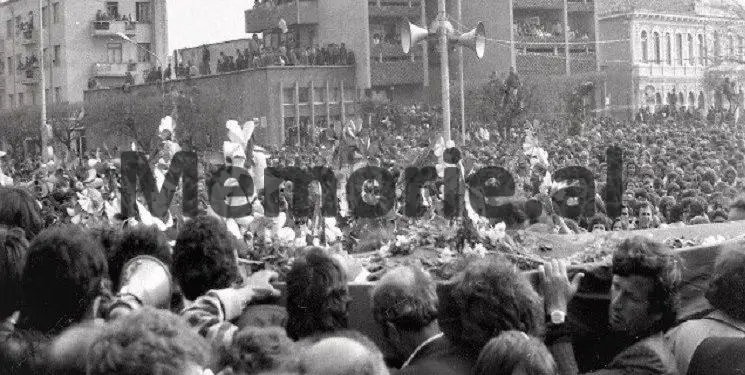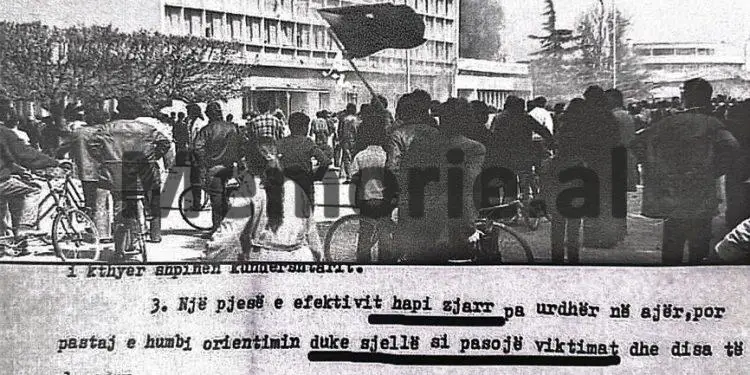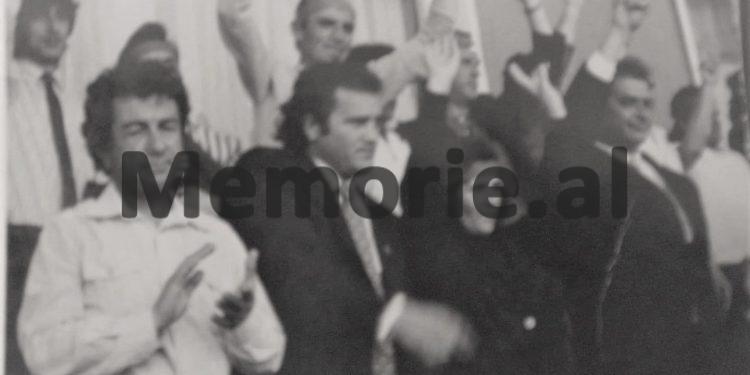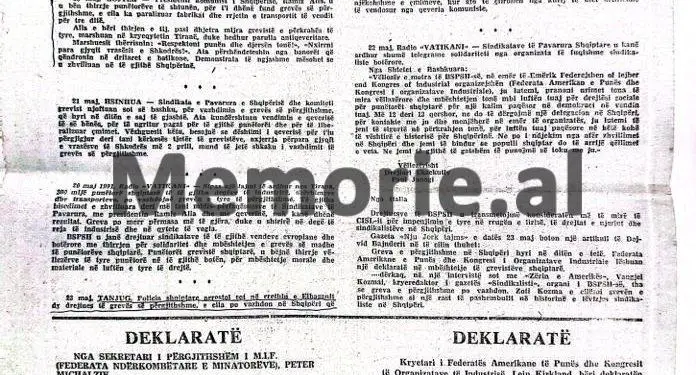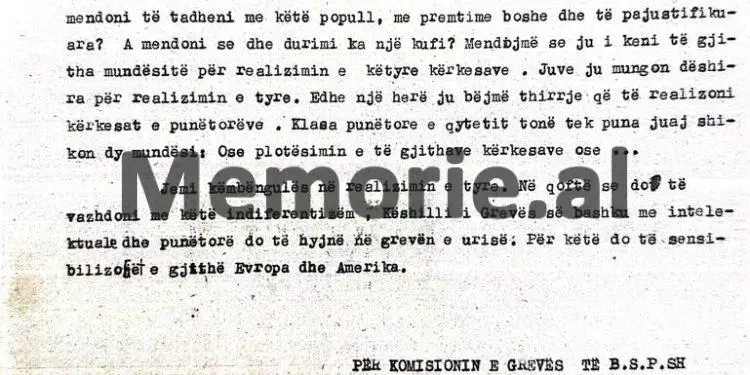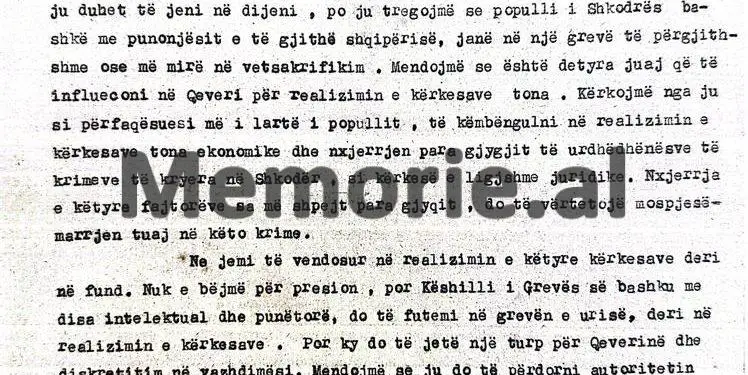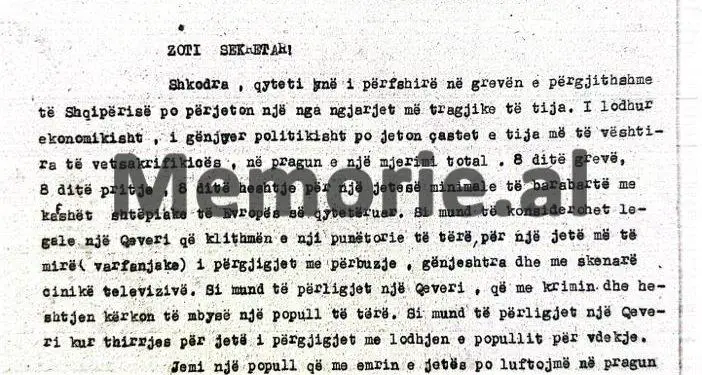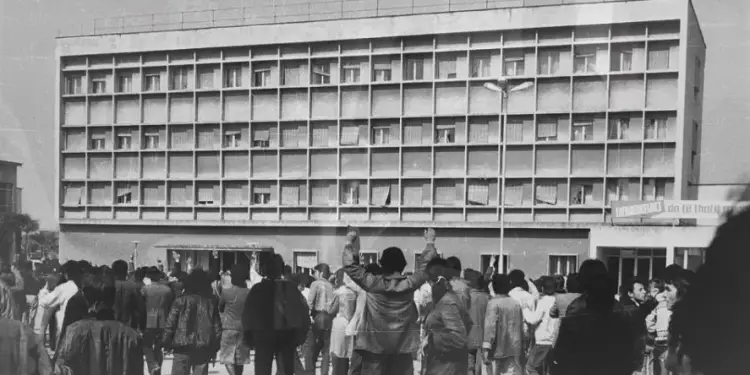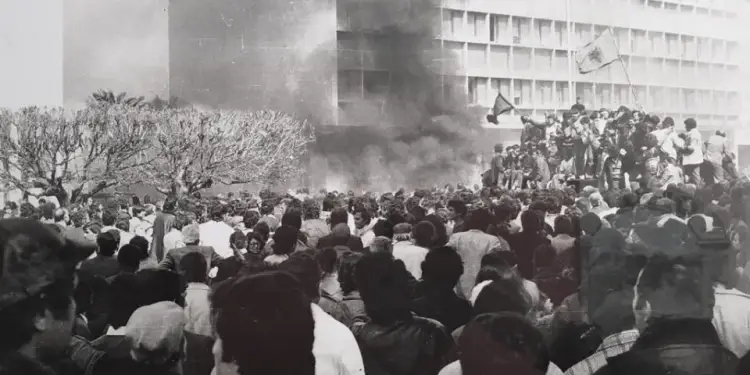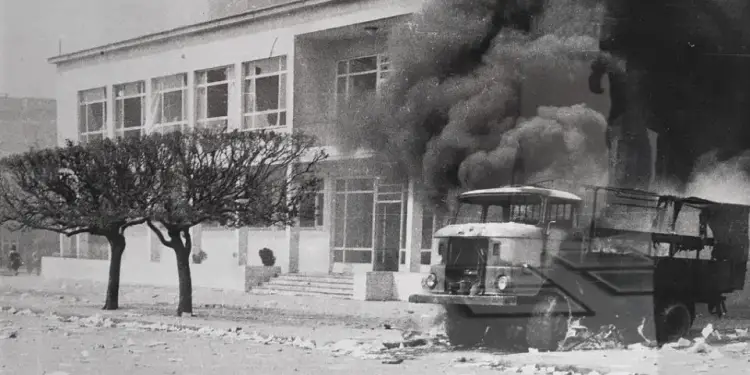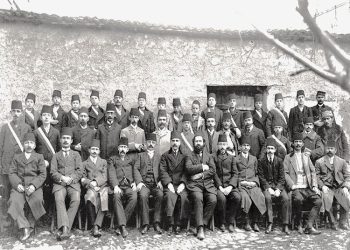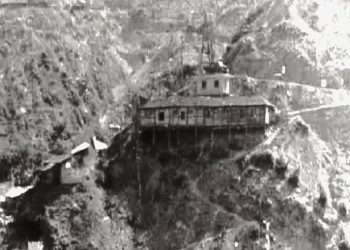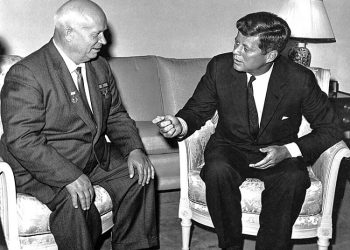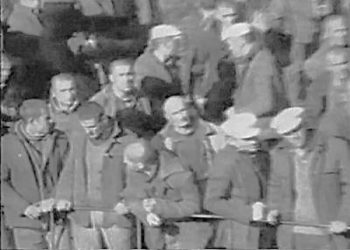By Tanush Mulleti
Second part
Reflections: “How I saw it, heard it and touched it on April 2, 1991, and how I hear it today”!
Memorie.al / April 2, 1991, has entered the history of Albania and is accepted even today by all wings of politics, as a monstrous and macabre crime, where 4 young boys were killed and over 97 people were injured, some of who remained disabled all their lives, all young men and women (as Umberto Eço says: “The truth and only the truth will save us”). The reason for writing these reflections is that we are hearing and reading, intentionally or unintentionally, the history of the event of April 2, 1991. For these notes, I was not driven by hatred, nor revenge, nor ambition, nor interest, but only conscience to tell the truth, publicly, as it happened.
Continues from last issue
Besnik Ceka’s grave was also opened!
In the back, he had a bullet hole, 13 to 14 centimeters, but rectangular. The bullets were not found, even a search with a metal detector! This was said, according to his sister (who was a doctor), that the bullets came out together with the blood from the hemorrhage. Upon finding the bullet, chief investigator Qemal Lame said: “Now the weapon that was used is also found”! I asked the question: “How do you find it, you”?! He said: “This is either a ‘TT’ pistol bullet, or a Chinese machine gun. From the inventory that was made, they lost 4-5 automatic weapons, different model”. We made a record, with almost 16 pages, and we were left with nothing but the denunciation to the Prosecutor’s Office. We announced through Radio-Shkodra that eyewitnesses who know or saw the murders should come.
In the offices of the Investigation, Shkodër, when we signed the minutes, I read the first reports about the event. Among other things, it said: “A part of the force lost control and shot at the crowd.” The forces that were used to forcibly disperse the demonstrators were very heterogeneous, consisting of Rapid Intervention Groups, policemen and soldiers of the 732nd Ward, with no experience. In another place in the Report dated 08.04.1991 it was written: “An officer opened fire in the air without orders, but then he lost his orientation due to the lack of compact actions, causing casualties and injuries. No chemicals were used because the head of Chemistry and a core trained for this purpose were missing that day.”
After the event, there was talk of the escape of 5 policemen, L.P. non-commissioned officer with origin and residence from the village of Mnelë, P.V., non-commissioned officer from Boga, F.R., non-commissioned officer from Grizha, P.O., non-commissioned officer from Gruemira, N.P., non-commissioned officer from Klosi, who have been on duty to guard the building of the Party Committee of Shkodër district .
According to a member of the Inventory Commission (economist A.L.), he stated in the press that, during April 2, 59,000 cartridges were spent. This can be verified. There was word that they will burn the building of the Investigation, for the loss of traces. Then, starting from this, the Independent Union guarded the building of the Investigation for two days and three nights, where at the head of that group were: Arben Borshi, Fritz Radovani, Ferdinand Temali, and others. At that time, the Prosecutor’s Office and the Investigation were near the English Tower, in the center of the city, somewhere in front of the “Rozafa” Tourism Hotel.
Together with Besnik Komi, we had a meeting with the representatives of the Prosecutor’s Office and the Investigation. “According to the advice of the President, we come to denounce the massacre”, they said. One of the representatives who came from the center, with the last name Leka, asked the first question: “Who burned the Party Committee”?! Besnik replied: “Protesters! The people of Shkodra”! He said: “The economic damage is 24 million”. Besniku said: “We will appeal to the people of Shkodra and we will collect 24 million ALL! This is how the compensation is done.”
At that moment, I intervened and said: “You find us now, who killed them! We have been dealing with these expertises for a month or so. Words, only words. Until now, we don’t even have anything concrete.” Besnik added: “You started the accusation wrongly. You should have told us: What you have done so far, and then tell us about the building. You put the building, more important than human life”. Then we went out. When we came out, there were waiting for us the comrades of the presidency and 30 people who wanted to testify. We saw that this was nothing and we left it. Those 30 people also left and ran away.
As a final conclusion, we respected all the legal requirements of the communist state. He didn’t answer. Only words and ramblings and ramblings! Then, there was nothing left but the strike! They didn’t answer again! Then, only the hunger strike remained. The leader of the hunger strike was Muhamet Gradeci, an intellectual with authority and reputation in Shkodran opinion.
The plan on the development of the hunger strike
The secretary, Mark Bardeli, resigned and went on hunger strike. The head of the union, Ferdinand Temali, also went on strike. Zefi remained secretary of the strike, but he too was in charge of work in the company. More or less, I covered that job. One day before the announcement of the strike, I was asked to meet with the leadership of the Trade Union in Tirana.
With an “IFA” car of the Tobacco-Cigarette Company, I also went directly to Valias, with a man from the Shkodër Brick Factory Union, Mit’hat Çaku. In the large hall in Valias, journalists and other people were gathered, as well as the chairman of the parliamentary group of the Labor Party, Lufter Xhuveli, the deputy speaker of the Parliament (of the PP), Lush Pëpali, deputy of the Labor Party, and some minister. Here too, the soldiers of the Guard of the Republic were roaming around in vain. In conclusion, the hunger strike in Valias had begun.
When we returned to Shkodër, in the evening, there was a big meeting of the Trade Unions in the hall of the Institute! I told them about the start of the strike in Valias and how the situation was. The next day, the hunger strike began in Shkodër. Everything was paralyzed. With the permission of the Strike Committee, some police services, PTT, hospitals, bakeries and essentials were allowed. Even the head of the District Executive Committee, Terezina Marubi, moved with the permission of the Strike Committee. The square before the strike in Piacë was covered with our posters and banners, prepared by the professional work of Fritz Radovan. Every day, after 17:00, the people filled the square in front of the building where the hunger strike took place.
A young imam used to ride on the shack and make religious prayers about the progress of the strike. I want to remember that, in all the pines and acacias, all the plaster animals from the Veterinary School were put, with the respective names of the members of the Political Bureau of the PPSh. It was a very enthusiastic situation, as information came out every day; it was a very beautiful thing. It is worth remembering the solidarity of the city of Shkodra, in support of the strike, as well as the solidarity of the villagers of the city of Shkodra. For example, with the initiative of a representative group of Buzeuji, Koplik, a movement started where, from all the villages, they brought different foods, eggs, cheese, and milk.
With our initiative, we put out an announcement, which said: “Whoever needs it, get these foods for free”! They did not come to take them! We took them to the Nursing Home and the Children’s Home. I remember a flagrant case; hanging out at 12 o’clock at night, like a dream, two policemen came and said: “Can we have a couple of eggs because we haven’t eaten all day”?! “Take as much as you want,” I told him. They each took 4 eggs, some cheese and onions and ran away. After her came a girl, (with a bad opinion among the people), she also did not take more than 4 grains of eggs, cheese and onions and ran away.
Then an old woman came and took 30 eggs. The most beautiful thing is that, the next day, the daughter of this old woman came and said: “Who is responsible here?” he said to me: “Look, my mother, she made a mistake and took 30 eggs.” No sir, these eggs are for those who don’t have any, we have a morsel of bread”. In other words, the people of Shkodra, in their poverty, did not accept theft and abuse. Even rightly is the expression that: “Fish stinks from the head”. That when he starts stealing above, those below will also steal.
Since the work of food and vegetables became a problem, we came to the conclusion that it was better to collect milk. Cars collected milk in the villages. We went to the River Bank. This milk was collected at the Milk Factory, under the direction of Ardian Cung, (currently residing in Canada), who has done an excellent job at that time. We collected enough milk; we decided to give children from 1-3 years of age free milk for three months.
The Reclamation Company in Shkodër, in addition to a truck, also made the workers’ bus available to students and citizens who needed to go to the hospital in Tirana, free of charge. The bus left at 9 a.m. and returned after 4 p.m. After that, help started coming from other districts and abroad. After a month of strikes, in a large meeting of the Trade Unions of Albania, the districts asked to act as Shkodra says. Before this fact, the Shkodra group headed by Muhamet Gradeci continued the strike, giving interviews to Radio-Shkodra and foreign radio stations that came with their correspondents from all over the world.
From the financial aid that came from other districts, at our expense, we took the injured Çlirim Bajri to Hungary, who was left disabled without an arm, for life. We have given all the injured a modest financial reward, which was distributed by Mark Bardeli, Tanush Mulleti and Paulin Pepa of the Wire Factory. We got the final lists of those killed and injured by the rubber batons from the lawyer Gjoleka, who collaborated with the director, Kujtim Çashku, as a representative of the Helsinki Commission for Human Rights.
Everyone had their own color photo card. The brother of the martyr, Arben Broci, a 17-year-old high school student, was also on strike. He got worse two or three times and we sent him to the hospital, in danger of his life. Together with Fritz Radovan, around twelve o’clock at night, we convinced him to leave the strike, on the condition that his mother would go to speak at the “Dinamo” stadium in Tirana. That’s how it happened. She gave a very touching speech, accompanied by Fritz Radovani, Eng. Fatlum Nurja and the chairman of the Union of Independent Trade Unions of Albania, ing. Cheers Shima.
I saw with my own eyes, a 17-year-old high school student, Harris Morina that the bullet entered his chest and exited from behind his back. (When I met him after 20 years, he was 1.85 cm and 100 kg…! The fate of man). On the second day of the strike, Viktor Martini, a former political prisoner, with some teenagers, removed Lenin’s bust from the flower garden near the Fire Department and took it to the middle of the city (in the center of the Square). People threw bicycle covers at his head.
A great job was done by the group of information journalists of the Albanian Radio-Television, “Zëri i América”, “RAI”, and several other newspapers that were published at that time. The government was completely paralyzed. The authority of the Shkodra Trade Union was a model. The government could not resist any longer. Many interventions were made to end the strike, and this work was also taken over by the head of the Trade Union Strike, Valer Xheka, without asking us. Xheka appeared on television and said: “When I tell you, the strike will end.” Ferdinand Temali, very precise, told him: “Who are you to end the strike?! We who are doing it end the strike, not you”. Clashes began.
The union of Tirana had avoided Mr. Gëzim Shima (Doctor of Sciences. Eng. of Radioactive Minerals), who had come and greeted the strike, while these others did not come,. In conclusion, after many debates, all the districts left it to Shkodra to decide whether the strike would end or not. We gathered at the Presidency of the Independent Trade Unions of Albania. In their offices, I saw the ambassadors, Ryerson (of the USA), Torquado Cardili (of Italy), as well as foreign journalists, etc. Skender Gjinushi, Abdi Baleta, etc. also came there.
Everyone claimed that the strike had to end as the country was heading towards disaster. Ben Afizi said: “What will we say to Shkodra now? We went on a hunger strike for a month, and what did we win?! Then, Muhamet Gradeci, said: “We will end the strike with two conditions that the elections that will be held in 1995 should be held in 1992 and the government should resign.” They were ready for this option, the government was also ready. With this action, we returned as winners to Shkodër.
After the meeting, together with Ben Hafizi, we were near the office of the editor-in-chief of the “Syndicalisti” newspaper, Kozma Vangjeli. Several foreign journalists were gathered there, as well as Ambassador Ryerson. I remember that Ryerson was very happy and enthusiastic that the strike was over. We were surprised! There was also Dervish Duma, journalist of the newspaper “Syndicalisti”, as well as his translator Sokol Muça.
The latter was a critic of the Americans and always accompanied the unionist American, Donald Shajmer, and Ben Hafizi asked the ambassador: “Why are you so happy”?! The ambassador returned it to us: “If the strike hadn’t ended, I would be in Washington tomorrow (he gestured with his hand). This conversation was done laughing and ing. Fatlum Nurja said with a laugh: “This means that, if he is not good at ending a strike of the Trade Union of Albania, the ambassador of the strongest state, what is he doing in Tirana”?! This conversation took place while laughing.
In conclusion, the Union of Independent Trade Unions of Albania carried out its moral and legal duty, starting from the bottom up, up to its President, for uncovering the truth about the murders of April 2, 1991, in the city of Shkodra and the punishment of their authors. For the first time in world history, a communist-Stalinist government surrendered and withdrew from the absolute direction of the state, only in the peaceful general strike, organized by the Union of Independent Trade Unions of Albania.
This is also the main, even decisive, merit of the Union of Trade Unions. If the Student Movement brought political pluralism, the General Strike of Trade Unions brought the free elections of 1992 and the acceleration of the arrival of freedom and democracy, towards European integration. If the elections were held in 1995, the Labor Party could produce President Lukashenko, for life.
The Trade Union Council, Shkodër branch, has a special merit; it became an example throughout Albania and the world, through radios, televisions, social networks, etc. This Council consisted of:
Chairman: Ferdinand Temali. Secretary: Arben Borshi. Members: Muhamet Gradeci, Fritz Radovani, Lela Zorba, Marina Rraposhta, Beniamin Hafizi, Ing. Fatlum Nurja, Mark Bardeli, Besnik Komi, Paulin Pepa, Naim Davidi, Skender Strica, Ing. Agron Sykja, Halit Haziz Rrustja, Ing. Fatmir Dragoti, Besnik Bekteshi, Xelal Fejza, Qazim Lika, Namik Mehmeti, Dr. Ramiz Hafizi, Eng. Ndrek Radovani, Smajl Kurtmema, Dr. Nard Shira, Beniamin Ademi, Bep Laloshi, Zef Prela, Bajram Agovi, Vincens Çefa, Tanush Mulleti, etc.
It is a moral and historical obligation for the current Municipality of Shkodra to place a commemorative plaque, where the hunger strike of the trade unionists took place, which overthrew the Communist Party led by Ramiz Alia, and accelerated the democratic processes. A good part of the Trade Union Council should be honored with the title “Honor of Shkodra”, at least for those who led it such as: Ferdinand Temali, Muhamet Gradeci, Fritz Radovani, Lela Zorba, Marina Rraboshta, Ing. Agron Sykja, etc.
The events of April 2, 1991, must be deeply analyzed. I told them as I have seen them with my own eyes and personally experienced them. Others should write their own. Tell them what I have seen. I take over and become the master of things that I have seen and touched myself. I am sure of one thing; I will not respond to some articles of memoirs that have appeared in recent years, about April 2 and the Trial, not Eduart Përjaku who wrote, nor lawyer Nazif Bezhani who wrote “The Murder of the Century”, or articles of Qemal Lame, Esat Myftari, Neshat Tozaj, etc., who directly accuse the Police.
I will focus my analysis only on three publications: The first book is written by Aredin Shyti, entitled “In the face of evil”, (published by the “Naimi” Publishing House, year 2022, 576 pages) which I think have served, since he was not present.
Also, the second book entitled: “Who killed on April 2”? Written by Gjekë Çelaj, (“Nervada” Publishing House, 2009, 250 pages), who was present at those events, until the building of the Party Committee burned by the protesters and the people of Shkodra was abandoned.
The third book is that of Shaqir Vukaj, “From the bloodshed of Shkodra Spring ’91, to the bloodshed of Albania Spring ’97”, (published by “Geer” Publishing House, year 2022, about 700 pages), where he shows how he saw it from the offices of the Executive Committee. Shaqir Vukaj, about the events of April 2, in the chapter “How I saw it”, is starting on page 69, until page 80, shows the progress of the event, seen by the Executive Committee, where, among other things, he writes:
“…Initially, there was a crowd of young people with bags in their hands, which was understood to be high school students who were just calling (as we found out later, they were students of the “Jordan Misja” high school). Others began to join them, mainly from the “29 November” high school!
“…The first signal showed that it would not be a peaceful protest…!
…Students with bags in their hands sat down in front of the Party Committee building, determined not to move from the site. At this time, the crowd kept coming and increasing, with people coming from all four directions, mostly young people…!
…At around 8:30 a.m., at a moment when it was not clear where it started, the police attacked the students with rubber batons, while the crowd retreated, towards the square, between the two committees…!
…Sometimes the police attacked the crowd; sometimes the crowd attacked the police. But the crowd kept growing and after a while, the square between the two committees was filled with people…
…I want to emphasize that; the first rifles were heard early, sometimes isolated shots and, sometimes automatic bursts, but not in bulk…! …It wasn’t long before around 11:00 a.m., smoke was seen coming out of the Party Committee building…!
(Note: the 4 killed and injured happened before 11 o’clock, before the burning of the Party Committee).
The first remark, in my opinion, is: Why did the Police attack the high school students sitting in the square? Second remark: When did the gunfights start?! The third remark: Why was the Police on April 1, peaceful and on April 2, violent? If we read the telegrams coming from the center, for the Internal Branch, Shkodër, it is more understandable that the signal was to respond with violence, without starting the organization. Here is what Aredin Shyti writes (His Book, page 122) about the telegram sent to the Shkoder Interior Branch on April 1, 1990:
“In the conditions that were created, I wrote the telegram with this content: In the March 31 elections, Ramiz Ali’s party won two thirds. This is of decisive importance for the future. All others, such as the issue of the constitution and the president, etc., depend on the Labor Party. What is required of us is to tighten our ranks and open our eyes, to show the country to the enemies and evildoers. Organize services to be ubiquitous. A. Shyti”
Then, regarding the telegram sent to all the Internal Affairs Branches in the districts, on page 127 of the book, he writes: “….on the morning of April 2, 1991, I wrote to all the Internal Affairs Branches, the telegram with this content: During yesterday, in the cities of Tirana, Shkodër and Kavajë, crowds of people have gathered illegally, throwing political and insulting slogans to personalities of the nation. Police forces intervened with agitation or did not intervene at all.
Such attitudes, after March 31, are very wrong. The police should intervene with the strictness of the law and whenever the use of force should be accompanied by the arrest of the culprits. To act with the force of the rubber stick, there is no reason for anyone to question those responsible. Strike hard right from the start of the build-up. To paralyze those who, from the crowd, may attack our forces with weapons, occupy the commanding heights with prepared marksmen. Our forces fighting the mobs should not go armed.” (My note T.M.: Part of the police).
It may not need a comment, but I will tell the genesis later. Memorie.al
The next issue follows





